TOYOTA C-HR 2022 Owners Manual
Manufacturer: TOYOTA, Model Year: 2022, Model line: C-HR, Model: TOYOTA C-HR 2022Pages: 818, PDF Size: 113.75 MB
Page 381 of 818
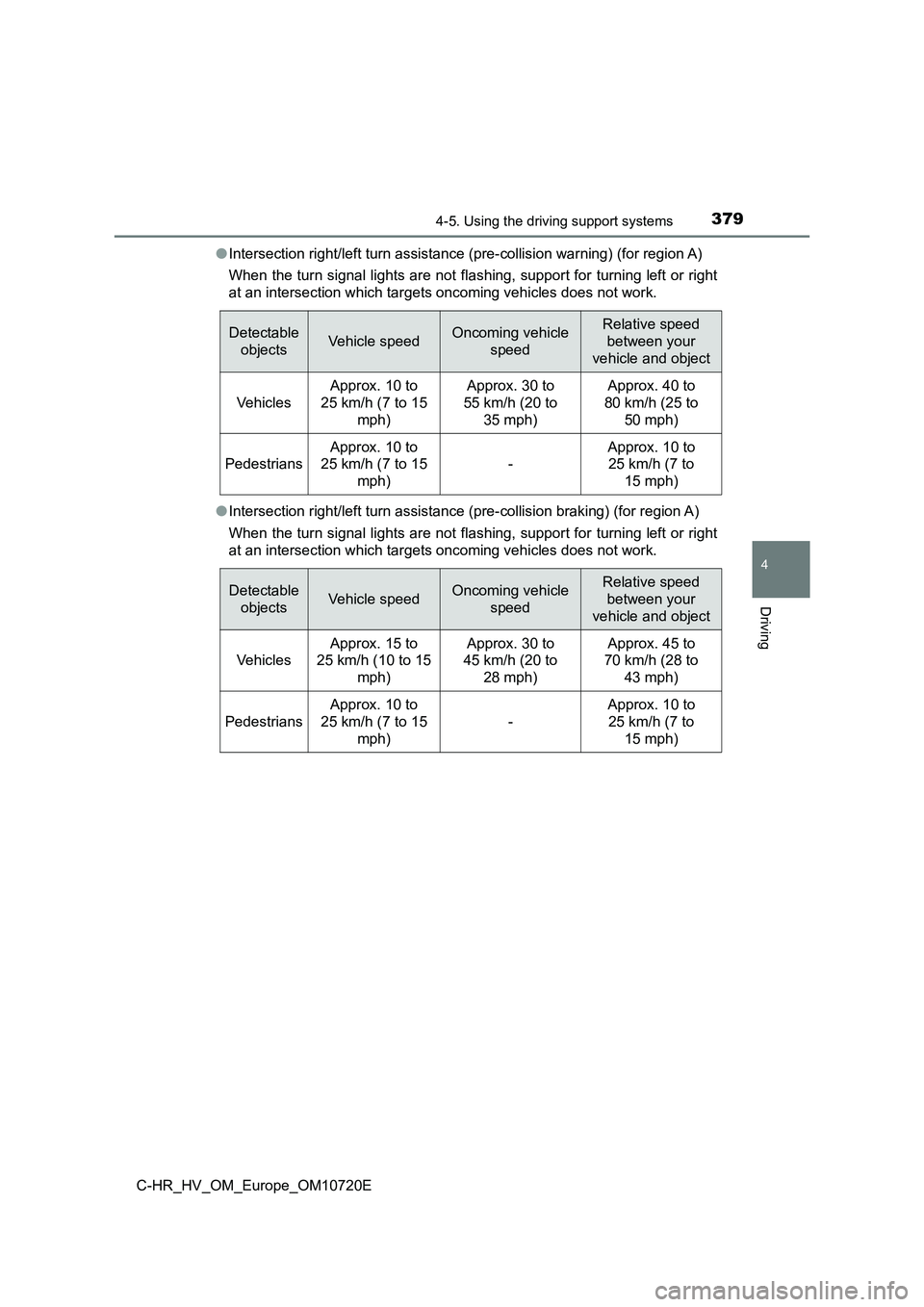
3794-5. Using the driving support systems
4
Driving
C-HR_HV_OM_Europe_OM10720E
● Intersection right/left turn assistance (pre-collision warning) (for region A)
When the turn signal lights are not flashing, support for turni ng left or right
at an intersection which targets oncoming vehicles does not wor k.
● Intersection right/left turn assistance (pre-collision braking) (for region A)
When the turn signal lights are not flashing, support for turni ng left or right
at an intersection which targets oncoming vehicles does not wor k.
Detectable
objectsVehicle speedOncoming vehicle
speed
Relative speed
between your
vehicle and object
Vehicles
Approx. 10 to
25 km/h (7 to 15
mph)
Approx. 30 to
55 km/h (20 to
35 mph)
Approx. 40 to
80 km/h (25 to
50 mph)
Pedestrians
Approx. 10 to
25 km/h (7 to 15
mph)
-
Approx. 10 to
25 km/h (7 to
15 mph)
Detectable
objectsVehicle speedOncoming vehicle
speed
Relative speed
between your
vehicle and object
Vehicles
Approx. 15 to
25 km/h (10 to 15
mph)
Approx. 30 to
45 km/h (20 to
28 mph)
Approx. 45 to
70 km/h (28 to
43 mph)
Pedestrians
Approx. 10 to
25 km/h (7 to 15
mph)
-
Approx. 10 to
25 km/h (7 to
15 mph)
Page 382 of 818

3804-5. Using the driving support systems
C-HR_HV_OM_Europe_OM10720E
■ Object detection function
The system detects objects based on their size, profile, motion , etc. However,
an object may not be detected depending on the surrounding brig htness and
the motion, posture, and angle of the detected object, preventi ng the system
from operating properly. ( P. 383)
The illustration shows an image of detectable objects.
■ Conditions under which the system may operate even if there is no pos-
sibility of a collision
● In some situations such as the following, the system may determine that
there is a possibility of a frontal collision and operate.
• When passing a detectable object, etc.
• When changing lanes while overtaking a detectable object, etc.
• When rapidly closing on a detectable object, etc.
• When approaching objects on the roadside, such as detectable o bjects,
guardrails, utility pol es, trees, or walls
Region A
Region B
• When approaching a detectable
object in an adjacent lane or on the
roadside, such as when changing the
course of travel or driving on a wind-
ing road
Page 383 of 818
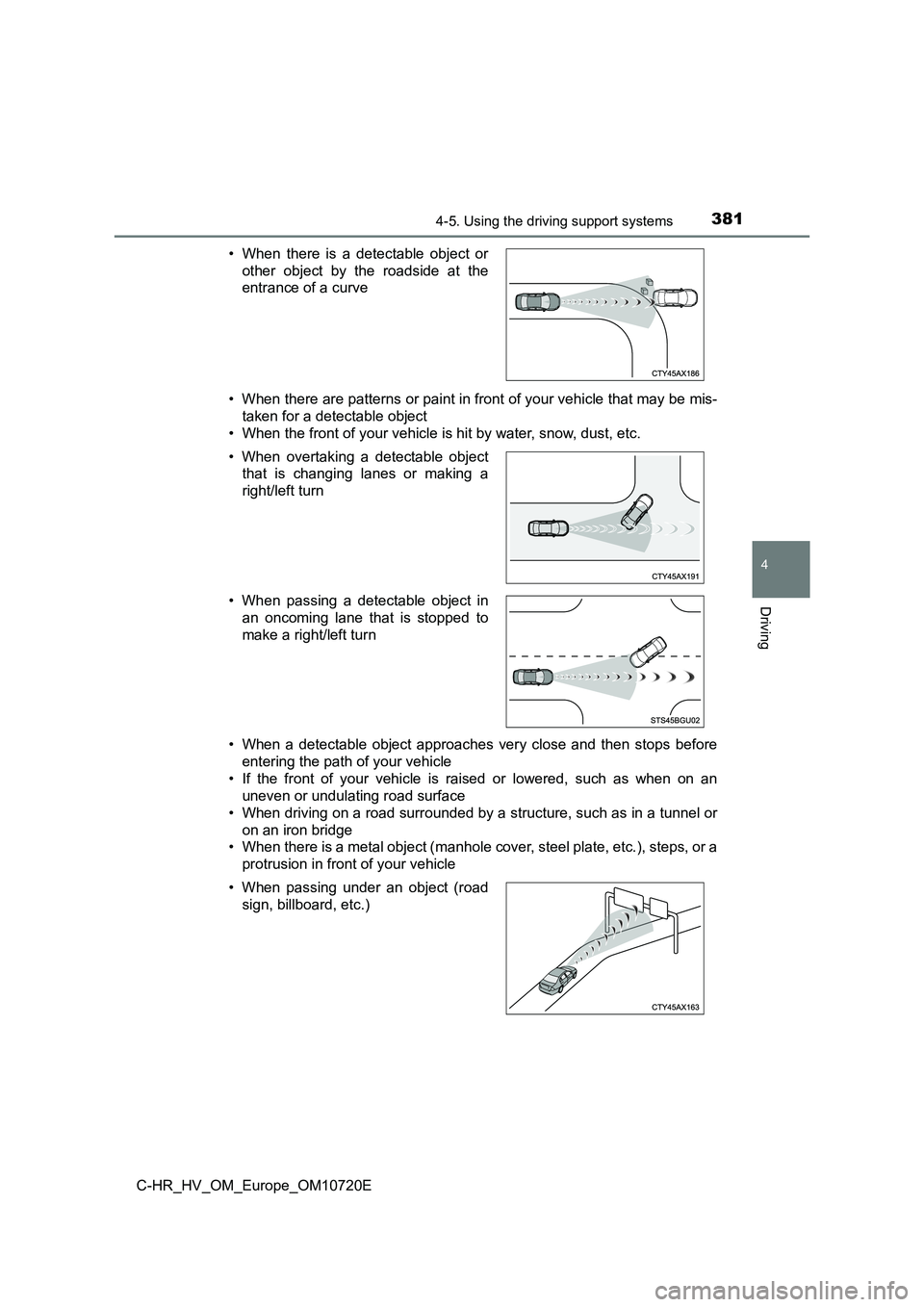
3814-5. Using the driving support systems
4
Driving
C-HR_HV_OM_Europe_OM10720E
• When there are patterns or paint in front of your vehicle that may be mis-
taken for a detectable object
• When the front of your vehicle is hit by water, snow, dust, et c.
• When a detectable object approaches very close and then stops before
entering the path of your vehicle
• If the front of your vehicle is raised or lowered, such as whe n on an
uneven or undulating road surface
• When driving on a road surrounded by a structure, such as in a tunnel or
on an iron bridge
• When there is a metal object (manhole cover, steel plate, etc. ), steps, or a
protrusion in front of your vehicle
• When there is a detectable object or
other object by the roadside at the
entrance of a curve
• When overtaking a detectable object
that is changing lanes or making a
right/left turn
• When passing a detectable object in
an oncoming lane that is stopped to
make a right/left turn
• When passing under an object (road
sign, billboard, etc.)
Page 384 of 818
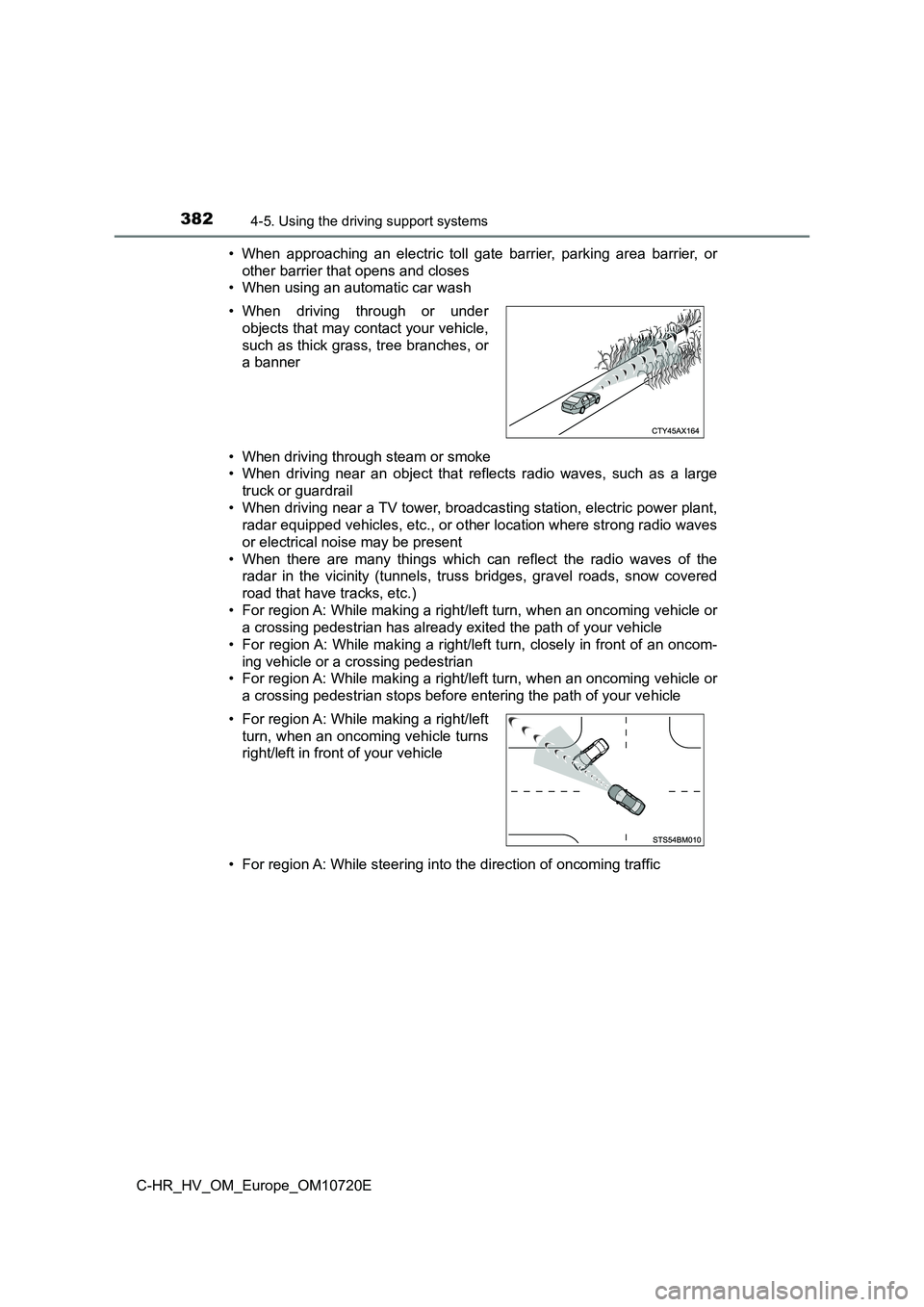
3824-5. Using the driving support systems
C-HR_HV_OM_Europe_OM10720E
• When approaching an electric toll gate barrier, parking area b arrier, or
other barrier that opens and closes
• When using an automatic car wash
• When driving through steam or smoke
• When driving near an object that reflects radio waves, such as a large
truck or guardrail
• When driving near a TV tower, broadcasting station, electric p ower plant,
radar equipped vehicles, etc., or o ther location where strong radio waves
or electrical noise may be present
• When there are many things which can reflect the radio waves o f the
radar in the vicinity (tunnels, truss bridges, gravel roads, sn ow covered
road that have tracks, etc.)
• For region A: While making a right/left turn, when an oncoming vehicle or
a crossing pedestrian has already exited the path of your vehic le
• For region A: While making a right/left turn, closely in front of an oncom-
ing vehicle or a crossing pedestrian
• For region A: While making a right/left turn, when an oncoming vehicle or
a crossing pedestrian stops before entering the path of your ve hicle
• For region A: While steering in to the direction of oncoming traffic
• When driving through or under
objects that may contact your vehicle,
such as thick grass, tree branches, or
a banner
• For region A: While making a right/left
turn, when an oncoming vehicle turns
right/left in front of your vehicle
Page 385 of 818
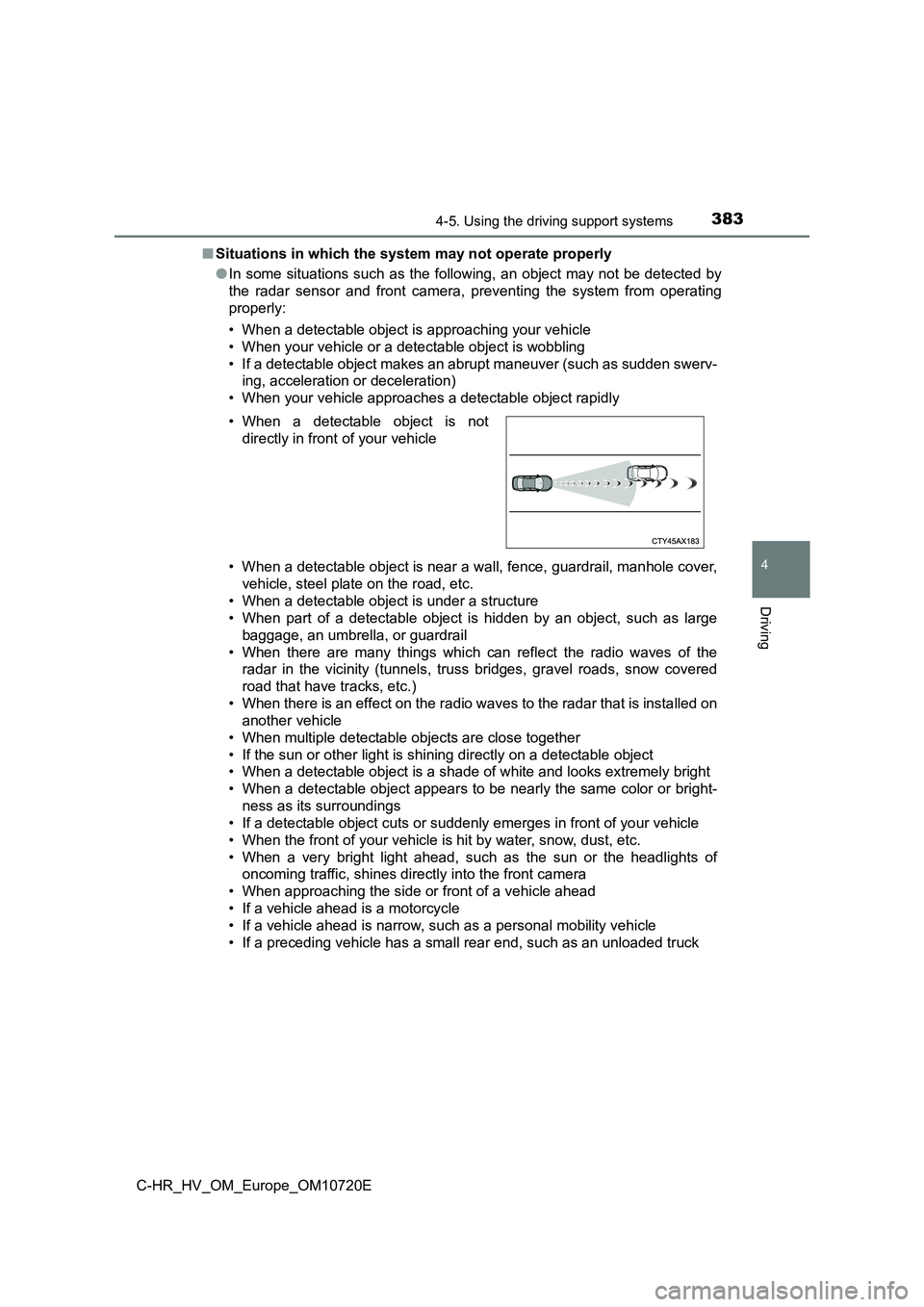
3834-5. Using the driving support systems
4
Driving
C-HR_HV_OM_Europe_OM10720E
■ Situations in which the system may not operate properly
● In some situations such as the following, an object may not be detected by
the radar sensor and front camera, preventing the system from o perating
properly:
• When a detectable object is approaching your vehicle
• When your vehicle or a detectable object is wobbling
• If a detectable object makes an abrupt maneuver (such as sudde n swerv-
ing, acceleration or deceleration)
• When your vehicle approaches a detectable object rapidly
• When a detectable object is near a wall, fence, guardrail, man hole cover,
vehicle, steel plate on the road, etc.
• When a detectable object is under a structure
• When part of a detectable object is hidden by an object, such as large
baggage, an umbrella, or guardrail
• When there are many things which can reflect the radio waves o f the
radar in the vicinity (tunnels, truss bridges, gravel roads, sn ow covered
road that have tracks, etc.)
• When there is an effect on the radio waves to the radar that i s installed on
another vehicle
• When multiple detectable objects are close together
• If the sun or other light is shining directly on a detectable object
• When a detectable object is a shade of white and looks extreme ly bright
• When a detectable object appears to be nearly the same color o r bright-
ness as its surroundings
• If a detectable object cuts or suddenly emerges in front of yo ur vehicle
• When the front of your vehicle is hit by water, snow, dust, et c.
• When a very bright light ahead, such as the sun or the headlig hts of
oncoming traffic, shines dir ectly into the front camera
• When approaching the side or front of a vehicle ahead
• If a vehicle ahead is a motorcycle
• If a vehicle ahead is narrow, such as a personal mobility vehi cle
• If a preceding vehicle has a small rear end, such as an unload ed truck
• When a detectable object is not
directly in front of your vehicle
Page 386 of 818
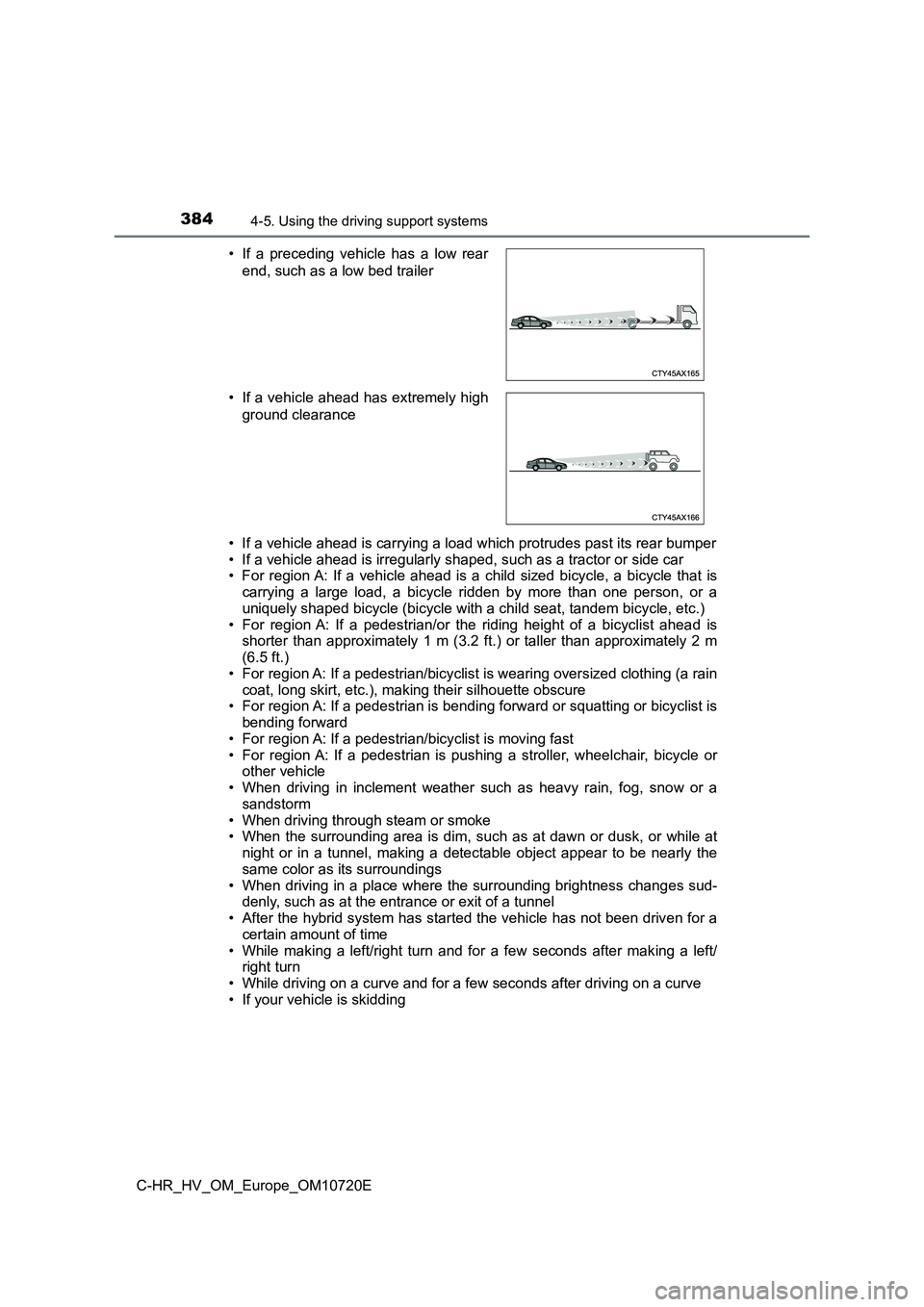
3844-5. Using the driving support systems
C-HR_HV_OM_Europe_OM10720E
• If a vehicle ahead is carrying a load which protrudes past its rear bumper
• If a vehicle ahead is irregularly shaped, such as a tractor or side car
• For region A: If a vehicle ahead is a child sized bicycle, a b icycle that is
carrying a large load, a bicycle ridden by more than one person , or a
uniquely shaped bicycle (bicycle with a child seat, tandem bicy cle, etc.)
• For region A: If a pedestrian/or the riding height of a bicycl ist ahead is
shorter than approximately 1 m (3.2 ft.) or taller than approxi mately 2 m
(6.5 ft.)
• For region A: If a pedestrian/bicy clist is wearing oversized clothing (a rain
coat, long skirt, etc.), making their silhouette obscure
• For region A: If a pedestrian is bending forward or squatting or bicyclist is
bending forward
• For region A: If a pedestrian/bicyclist is moving fast
• For region A: If a pedestrian is pushing a stroller, wheelchai r, bicycle or
other vehicle
• When driving in inclement weather such as heavy rain, fog, sno w or a
sandstorm
• When driving through steam or smoke
• When the surrounding area is dim, such as at dawn or dusk, or while at
night or in a tunnel, making a detectable object appear to be n early the
same color as its surroundings
• When driving in a place where the surrounding brightness chang es sud-
denly, such as at the entrance or exit of a tunnel
• After the hybrid system has started the vehicle has not been d riven for a
certain amount of time
• While making a left/right turn and for a few seconds after mak ing a left/
right turn
• While driving on a curve and for a few seconds after driving o n a curve
• If your vehicle is skidding
• If a preceding vehicle has a low rear
end, such as a low bed trailer
• If a vehicle ahead has extremely high
ground clearance
Page 387 of 818
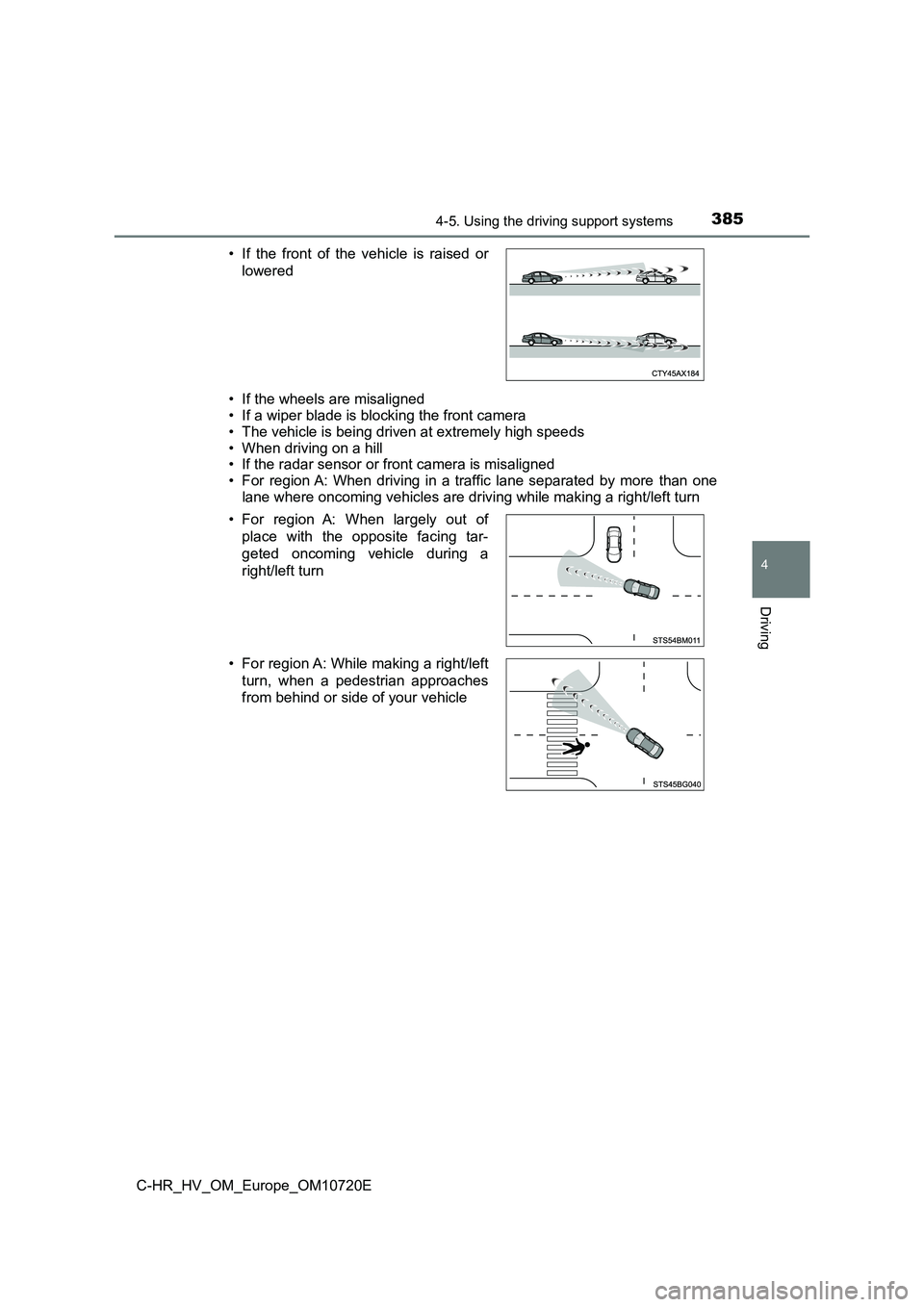
3854-5. Using the driving support systems
4
Driving
C-HR_HV_OM_Europe_OM10720E
• If the wheels are misaligned
• If a wiper blade is blocking the front camera
• The vehicle is being driven at extremely high speeds
• When driving on a hill
• If the radar sensor or front camera is misaligned
• For region A: When driving in a traffic lane separated by more than one
lane where oncoming vehicles are driving while making a right/l eft turn
• If the front of the vehicle is raised or
lowered
• For region A: When largely out of
place with the opposite facing tar-
geted oncoming vehicle during a
right/left turn
• For region A: While making a right/left
turn, when a pedestrian approaches
from behind or side of your vehicle
Page 388 of 818
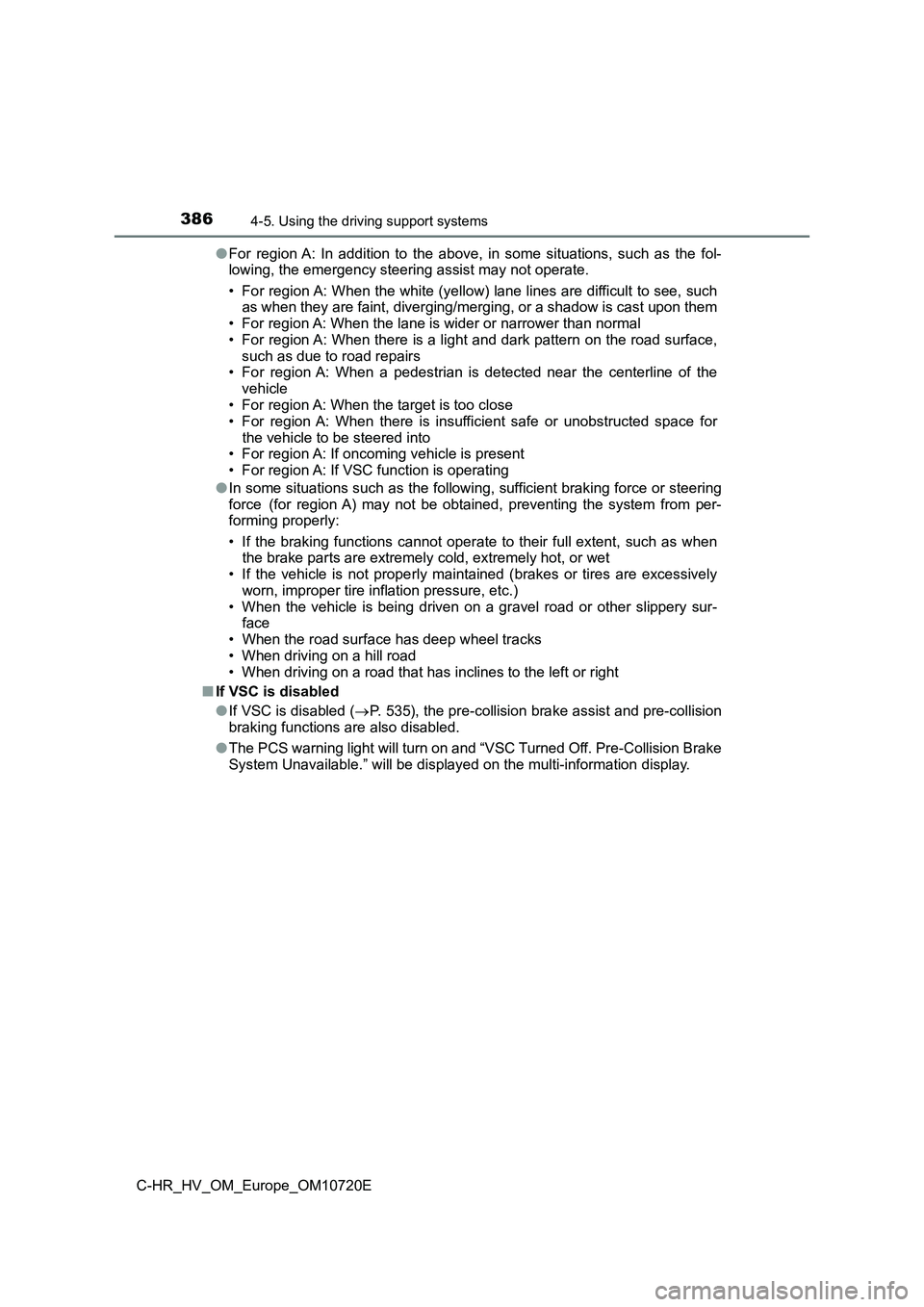
3864-5. Using the driving support systems
C-HR_HV_OM_Europe_OM10720E
● For region A: In addition to the above, in some situations, such as the fol-
lowing, the emergency steering assist may not operate.
• For region A: When the white (yellow) lane lines are difficult to see, such
as when they are faint, diverging/merging, or a shadow is cast upon them
• For region A: When the lane is wider or narrower than normal
• For region A: When there is a light and dark pattern on the ro ad surface,
such as due to road repairs
• For region A: When a pedestrian is detected near the centerlin e of the
vehicle
• For region A: When the target is too close
• For region A: When there is insufficient safe or unobstructed space for
the vehicle to be steered into
• For region A: If oncoming vehicle is present
• For region A: If VSC function is operating
● In some situations such as the following, sufficient braking force or steering
force (for region A) may not be obtained, preventing the system from per-
forming properly:
• If the braking functions cannot operate to their full extent, such as when
the brake parts are extremely cold, extremely hot, or wet
• If the vehicle is not properly maintained (brakes or tires are excessively
worn, improper tire inflation pressure, etc.)
• When the vehicle is being driven on a gravel road or other sli ppery sur-
face
• When the road surface has deep wheel tracks
• When driving on a hill road
• When driving on a road that has inclines to the left or right
■ If VSC is disabled
● If VSC is disabled (P. 535), the pre-collision brake assist and pre-collision
braking functions are also disabled.
● The PCS warning light will turn on and “VSC Turned Off. Pre-Collision Brake
System Unavailable.” will be displayed on the multi-information display.
Page 389 of 818
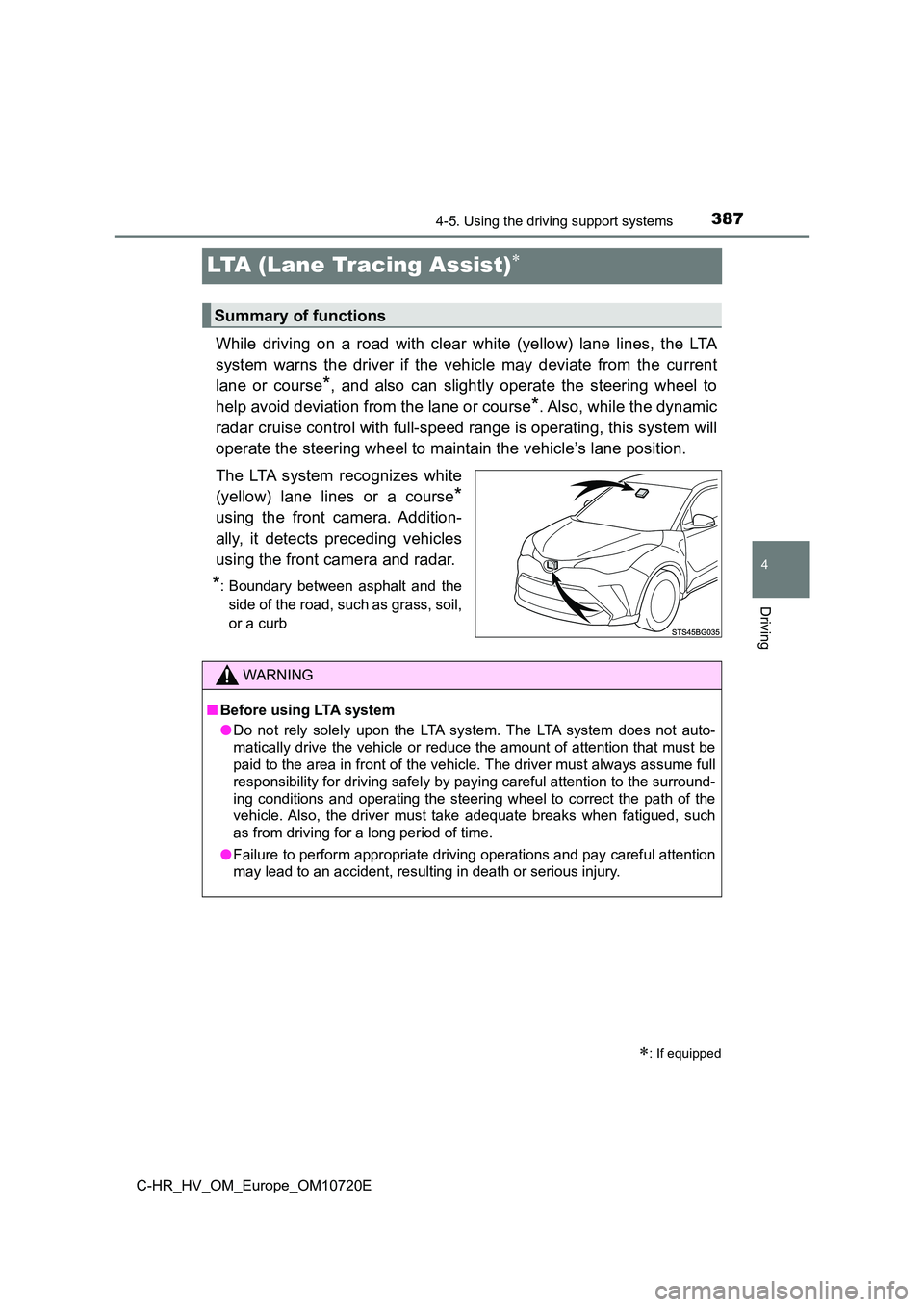
387
4
4-5. Using the driving support systems
Driving
C-HR_HV_OM_Europe_OM10720E
LTA (Lane Tracing Assist)
While driving on a road with clear white (yellow) lane lines, the LTA
system warns the driver if the vehicle may deviate from the cur rent
lane or course*, and also can slightly operate the steering wheel to
help avoid deviation from the lane or course*. Also, while the dynamic
radar cruise control with full-speed range is operating, this s ystem will
operate the steering wheel to maintain the vehicle’s lane posit ion.
The LTA system recognizes white
(yellow) lane lines or a course*
using the front camera. Addition-
ally, it detects preceding vehicles
using the front camera and radar.
*: Boundary between asphalt and the
side of the road, such as grass, soil,
or a curb
: If equipped
Summary of functions
WARNING
■ Before using LTA system
● Do not rely solely upon the LTA system. The LTA system does not auto-
matically drive the vehicle or reduce the amount of attention t hat must be
paid to the area in front of the vehicle. The driver must always assume full
responsibility for driving safely by paying careful attention t o the surround-
ing conditions and operating the steering wheel to correct the path of the
vehicle. Also, the driver must take adequate breaks when fatigu ed, such
as from driving for a long period of time.
● Failure to perform appropriate driving operations and pay careful attention
may lead to an accident, resulting in death or serious injury.
Page 390 of 818
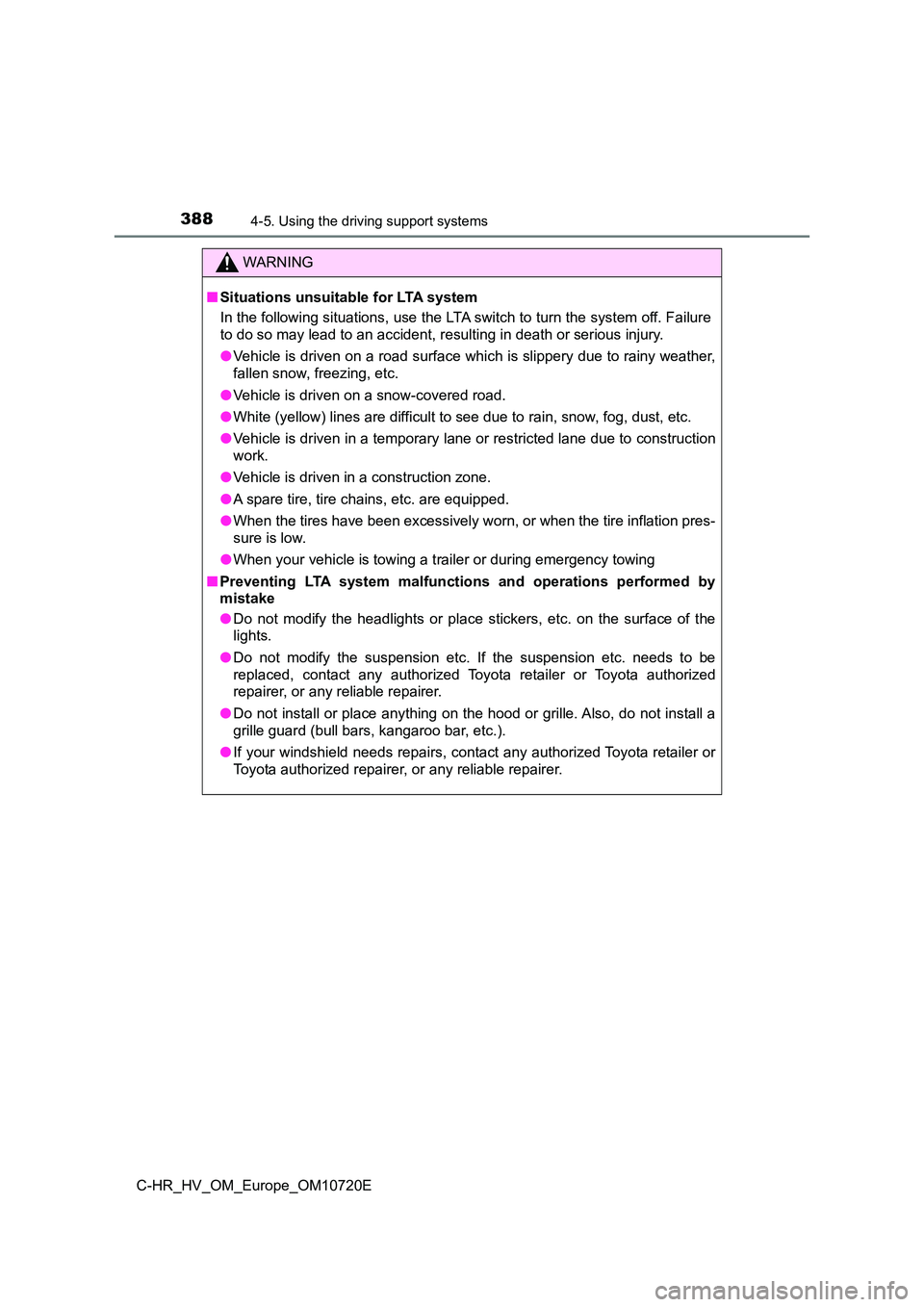
3884-5. Using the driving support systems
C-HR_HV_OM_Europe_OM10720E
WARNING
■Situations unsuitable for LTA system
In the following situations, use the LTA switch to turn the sys tem off. Failure
to do so may lead to an accident, resulting in death or serious injury.
● Vehicle is driven on a road surface which is slippery due to rainy weather,
fallen snow, freezing, etc.
● Vehicle is driven on a snow-covered road.
● White (yellow) lines are difficult to see due to rain, snow, fog, dust, etc.
● Vehicle is driven in a temporary lane or restricted lane due to construction
work.
● Vehicle is driven in a construction zone.
● A spare tire, tire chains, etc. are equipped.
● When the tires have been excessively worn, or when the tire inflation pres-
sure is low.
● When your vehicle is towing a trailer or during emergency towing
■ Preventing LTA system malfunctions and operations performed by
mistake
● Do not modify the headlights or place stickers, etc. on the surface of the
lights.
● Do not modify the suspension etc. If the suspension etc. needs to be
replaced, contact any authorized Toyota retailer or Toyota auth orized
repairer, or any reliable repairer.
● Do not install or place anything on the hood or grille. Also, do not install a
grille guard (bull bars, kangaroo bar, etc.).
● If your windshield needs repairs, contact any authorized Toyota retailer or
Toyota authorized repairer, or any reliable repairer.